From my experience I can say, that sometimes, you don’t need more answers—just a quieter place to hear them. Tucked away in the serene landscapes of Gurdaspur district, there stands a temple that doesn’t seek attention. It simply holds space, patiently inviting those who are ready to listen. Friends we are talking about divine- Pandori Dham, in the Gurdaspur city. It’s more than a temple—It’s a pause.
As someone who travels frequently. Chasing stories, filming life, and somewhere along the way, seeking moments of inner peace. I’ve found this place to be a constant. Being Punjabi by origin, my visits home are annual. But this shrine? I make it a point to return and seek the divine connect, as often as I can. Not for ritual alone, but for what it does to my mind.
Pandori Dham isn’t just a spiritual destination in India, it’s a conscious retreat. Here in the divine blessings silence heals louder than sermons. The temple doesn’t just offer darshan. It offers clarity.
So this isn’t just a feature. It’s a personal return. And every time, it brings me back to myself.
Also Read:
- Chorabari Tal: Exploring Shiva’s Sacred Himalayan Abode
- Lord Hanuman Story: Divine Birth, Powers, and the Symbolism
History of Pandori Dham – A Sacred Legacy
Before Pandori Dham became a place of pause and inner quiet, it was a seed of devotion planted in the soil of Punjab over 550 years ago. Its story blends spiritual tradition, fearless faith, and the timeless pull of divine connection.
Who Founded Pandori Dham?
Pandori Dham was established by Shri Bhagwanji. A revered Dogra Khajuria Brahmin from Kahnuwan in the Gurdaspur district. His spiritual path led him to Krishnadas Payahari, a revered saint of Galta Dham in Rajasthan, and an influential voice in the Ramanandi Vaishnav Sampradaya.
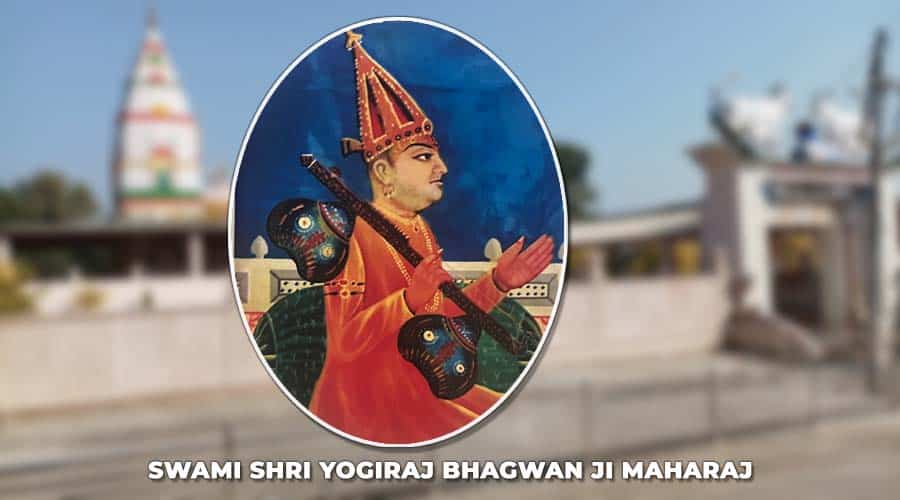
Under Krishnadas’s guidance, Bhagwanji was initiated into a tradition that honoured devotion to Lord Raghunath (Rama) and the practice of selfless service. With those teachings, he returned to Punjab and laid the foundation for Pandori Dham, which is locally known as Thakurdwara Bhagwan Narainji.
A Gateway Among the 52 Vaishnav Dvaras
Pandori Dham is not an isolated shrine. It is mentioned in the Census of India 1991, Pandori Dham is officially recognized as one of 52 Vaishnava Dvaras of Bairagi community. These sacred centres represent access points to a deeper experience of devotion, reflection, and divine discipline.
As one of the significant temples in Punjab, Pandori Dham became a place where mindfulness travel and spiritual inquiry converge, drawing seekers who value both inner silence and cultural legacy.
The Folklore: Mahant Narainji and Emperor Jahangir
Among the many stories tied to Pandori Dham, one of the most powerful is the tale of Mahant Narainji. Emperor Jahangir, doubtful of the Mahant’s spiritual power, commanded that poison be administered to test his resilience. When Narainji remained unharmed, Jahangir reportedly bowed in reverence. In his memoir Tuzk-e-Jahangiri, the emperor wrote,

I was astonished by the faqir’s calmness. Even after taking what should have ended life, he sat in peace. Such is the strength of those who walk with God– Jahangir
This tale continues to echo through generations. Reminding us that true devotion transcends logic. In the quiet surrender of faith, even emperors must bow before the power of the divine.
Present-Day Guru: Shri 1108 Raghubir Daas Ji Maharaj
Following the sacred ascension of Dwaracharya Shri Mahant Gobind Dass Ji Maharaj, the spiritual mantle was gracefully passed on to the present Guru. The spiritual legacy of Pandori Dham continues under the guidance of Shri 1108 Raghubir Daas Ji Maharaj, a visionary leader and spiritual teacher in his early 40s.
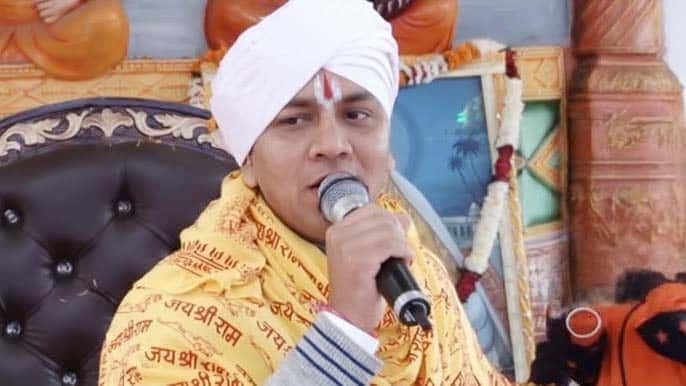
Deeply rooted in the Vaishnav tradition, he has revitalized the Dham’s outreach by blending devotional teachings with contemporary relevance. His discourses draw thousands, and he actively promotes seva (selfless service), spiritual discipline, and inclusive community welfare.
Maharaj Ji envisions Pandori Dham not just as a place of worship, but as a conscious retreat. A sanctuary for self-transformation, cultural revival, and mindful living for future generations.
Rituals and Festivals at Pandori Dham-A Sacred Daily Rhythm
In Pandori Dham, every ritual is a quiet rhythm that invites stillness. From early morning chants to evening offerings, the temple’s daily life offers more than tradition—it offers presence, discipline, and peace.
Morning to Evening – A Day at Pandori Dham
The day at Pandori Dham begins with aarti and kirtan. The echoes of the bells fills the temple with sacred sounds that ease the mind into calm. Devotees seek darshan of the deity, offering quiet prayers and receiving prasad, often in the form of batasha or sweets.
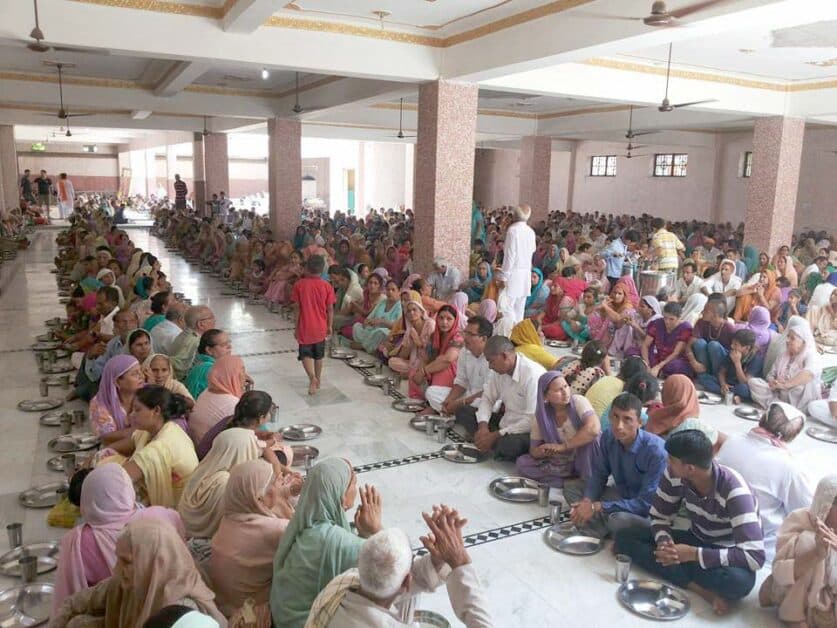
At around 1 PM is the time for langar to be served to all visitors. This simple, nourishing meal becomes a moment of spiritual equality and shared community. Later in the evening, tea and snacks are distributed. The setting sun adds its warmth and deepens the spirit of shared togetherness.
The Sacred Cycle of Seva and Reverence
At the heart of Pandori Dham’s spiritual retreat is seva, or selfless service. Devotees contribute in ways that go beyond ritual:
- Donating blankets, bedding, or grain for temple use
- Volunteering during langar or festive preparations
- Participating in cleaning, arranging flowers, or serving water
These simple offerings transform into acts of devotion, grounding the devotee in humility and heartfelt gratitude.
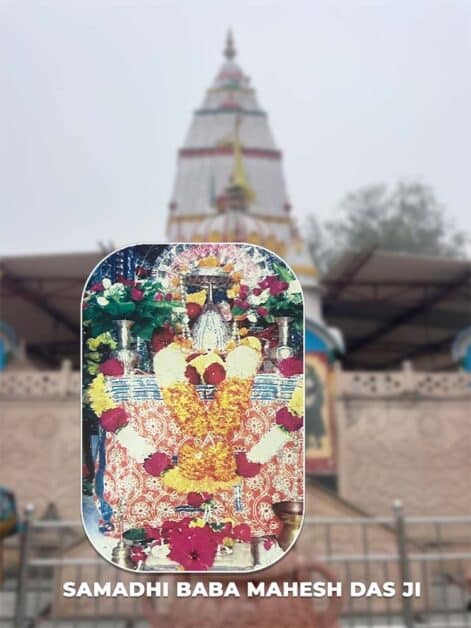
A unique local custom involves bowing before Baba Mahesh Das Ji’s shrine. It has to be followed, both upon entering and exiting the premises. It is believed this completes the spiritual cycle of one’s visit.
Baisakhi Fair – A Celebration of Spirit and Community
Celebrated annually from the 1st to 3rd of Vaisakha. The Baisakhi Fair stands as the temple’s most vibrant and cherished festival. It features:
- Processions led by temple musicians and locals
- Navagraha puja to balance planetary influences
- Distribution of patasha prasad in the evenings
- Spiritual discourses and kirtans drawing visitors from across Punjab
Rituals here aren’t just a day routine. They are meditative anchors that turn ordinary days into sacred experiences.
Beyond Devotion – A Sensory Retreat for the Mindful Soul
Not every spiritual experience comes from prayer. Sometimes, it begins in silence, in scent, or in the soft rustle of leaves underfoot. You don’t confine yourself to just rituals at Pandori Dham. Devotion begins in the senses that come alive the moment you step in.

A Landscape Designed for Presence
The temple complex is more than sacred architecture. A tranquil magical pond rests at the heart of the dham, mirroring the sky like a silent reflection of the soul. Around it, manicured gardens, blooming flowers, and the soft calls of peacocks offer a rare kind of peace. The presence of a cow shelter (gaushala)adds to the harmony, grounding the spiritual with the everyday.
What is the story behind the “magical pond” at Pandori Dham?
The sacred pond at Pandori Dham is steeped in legends that reveal both divine power and saintly grace.
Tilted Pond: Folklore
Legend tells of a mysterious woman believed to be a sorceress who once came to the pond screaming wildly. With each cry, the water level dropped mysteriously. Shri Hariram Ji intervened with sacred mantras and rice, reversing the effect step by step. She fled, leaving the pond permanently tilted—a visible reminder of his yogic power.

Ganges Water from Haridwar: Folklore
The most famous tale is tied to Haridwar. While bathing at Har Ki Pauri, Shri Hariram Ji’s attendant dropped a brass lota into the Ganga. Though lost to the river’s current, the saint assured him it would be found. Days later, back at Pandori Dham, Shri Hariram Ji dipped his hand into the temple pond and retrieved the same lota—effortlessly. Those who witnessed it were stunned.
Since then, the pond is considered miraculous. Bathing here, especially on the first Sunday of the month, is believed to bring healing and divine blessings.

A Soundscape of Stillness
From early morning to dusk, the air carries the gentle rhythm of bhajans, the occasional clang of a temple bell. The footsteps of seekers walking barefoot. These sounds are not interruptions—they are invitations. You may find yourself slowing down, breathing deeper, or simply listening without thought.
What makes Pandori Dham a mindful travel destination?
Pandori Dham offers a sensory experience. It draws you in. The scent of incense, the gentle touch of temple grass. The warmth of prasad resting in your palm—each quiet detail weaves into a deeply felt, full-body experience. It is in this subtle immersion that inner peace begins to rise.
For many, this setting becomes more than a spiritual retreat. It becomes a return to conscious awareness, where stillness is not empty, but alive.
Dhianpur – The Sacred Companion in the Spiritual Journey
A spiritual journey often finds its wholeness not in one place, but in a pair of sacred spaces that reflect and balance each other. Just a short distance from Pandori Dham lies Dhianpur, a destination that completes the circle.
A Nearby Sanctuary Rooted in Sikh Tradition
Just 13 kilometers from Pandori Dham in Gurdaspur district, Dhianpur Dham houses the revered Gurudwara of Baba Lal Dayal Ji. The site holds deep spiritual significance for followers of Sikhism and has long been associated with stillness, humility, and deep inner focus. Its atmosphere mirrors the quiet strength of Pandori, yet offers its own unique sense of surrender through Sikh practice.
A Journey in Spiritual Balance
Pilgrims visiting Pandori Dham often extend their journey to Dhianpur. While Pandori represents Vaishnav devotion rooted in rituals, kirtan, and meditation on Lord Raghunath, Dhianpur reflects Sikh values of oneness, equality, and service. This combination invites seekers into a multi-faith spiritual experience, where different paths share common ground.
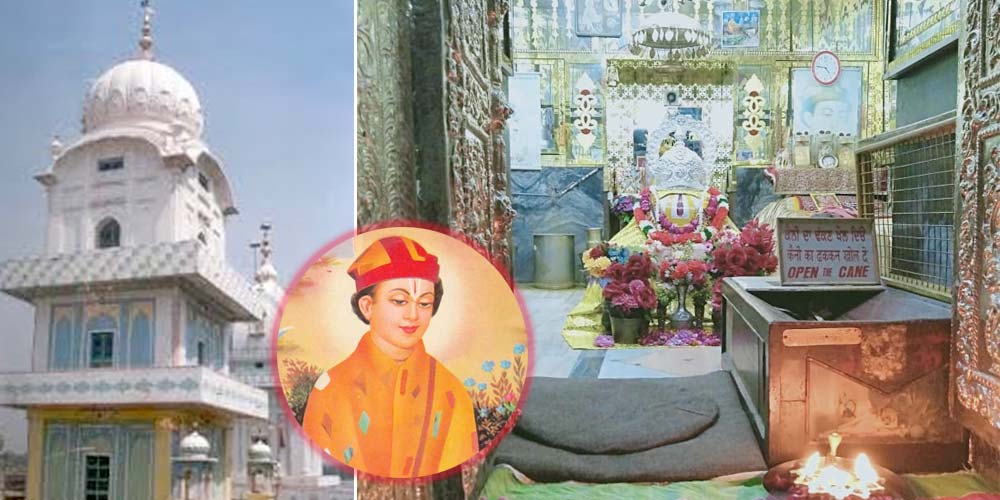
The shared values of seva (selfless service), humility, and spiritual surrender run through both sites, making the two temples feel like chapters in the same sacred story. Together, they offer not just diversity of practice, but unity in intention.
Pilgrims often visit both sites for a balanced spiritual experience rooted in devotion and selfless service. Dhianpur and Pandori together craft a complete spiritual narrative of Punjab.
Pandori Dham as a Conscious Retreat – Not Just a Temple
In an age of constant noise, travel has become more than escape—it’s a way to return to ourselves. Many seekers now look for places that offer mindful disconnection from digital chaos and emotional overwhelm. Pandori Dham meets that need not through luxury, but through stillness.
As interest in slow travel and spiritual retreats grows, this temple in the Gurdaspur district quietly stands out. It offers:
- Silence without loneliness
- Rituals with reason
- Community without noise
A well-known and revered Hindu temple, Shri Pindori Dham holds deep spiritual significance. Shri Raghubir Dass Ji is the 16th Gaddi of this sacred place in Gurdaspur. People from across the country visit here, drawn not only by tradition but by unwavering faith—regardless of religion — Akashdeep Dwivedi
Maharaj’s Dog Who Ate Opium: A Tale of Yogic Power and Humility
This tale offers a fascinating blend of wisdom, miracle, and moral authority. In the court of Emperor Jahangir, Baba Narayanji’s Gurubhai—another saint from Pandori Dham, was once tested for his yogic powers. Jahangir mockingly asked, “Are you an Amalpani (one who consumes narcotics)?”
The saint pointed toward his dog and said, “No, but my dog sometimes consumes opium.” Intrigued, Jahangir offered a small dose. The dog calmly consumed it. The dose was increased, and the dog still remained unaffected. Eventually, a full chest containing over a maund (approx. 37 kg) of opium was brought from Jahangir’s treasury. Astonishingly, the dog consumed it all—without harm.

Stunned, Jahangir fell at the saint’s feet. To which the saint replied:
“अफीम सवा मन खाय के फेर तजै नहीं प्राण।
तिनकी महिमा क्या कहूँ, सिद्ध हैं जिनके श्वान।।”
“Even a dog blessed by the yogi digests over a maund of opium without dying. What words can describe the power of those saints?”
He then reminded Jahangir of his past injustice to Shri Narayanji, whom he had once poisoned. Humbled and transformed, Jahangir went in search of Shri Narayanji, found him in the forest, and bowed in repentance at his feet.
Pandori Dham is not framed for photographs. It’s shaped for presence. It doesn’t demand you believe—it simply invites you to breathe. Pandori Dham is not about what you do—it’s about what you feel.
Places to Explore Nearby – Spiritual and Natural Extensions
A journey to Pandori Dham often opens the door to other experiences in the region. The surrounding areas of Gurdaspur district offer both spiritual depth and peaceful escapes, enriching your retreat with history, nature, and reflection.
Nearby Destinations Worth Visiting
- Dhianpur Dham: Just 13 km away, this Gurudwara balances the Vaishnav tradition of Pandori with Sikh stillness and seva.
- Mukteshwar Mahadev Temple: A centuries-old cave temple carved into the rocks beside the Ravi River, offering a serene setting for deep reflection.
- Fish Park, Gurdaspur: A family-friendly green space offering simple joys and gentle pauses.
- Kalanaur: Home to a truly unique Prachin Shiva temple. This sacred site features a “Svayambhu” Shivalinga in a rare horizontal position which grows every year on its own. A rare spiritual marvel, the place also marks in history; it was here that Emperor Akbar was coronated in 1556.
- Kathgarh Shiv Mandir: A twin Shivling temple located near Pathankot, known for its unique geometry and sacred ambiance.
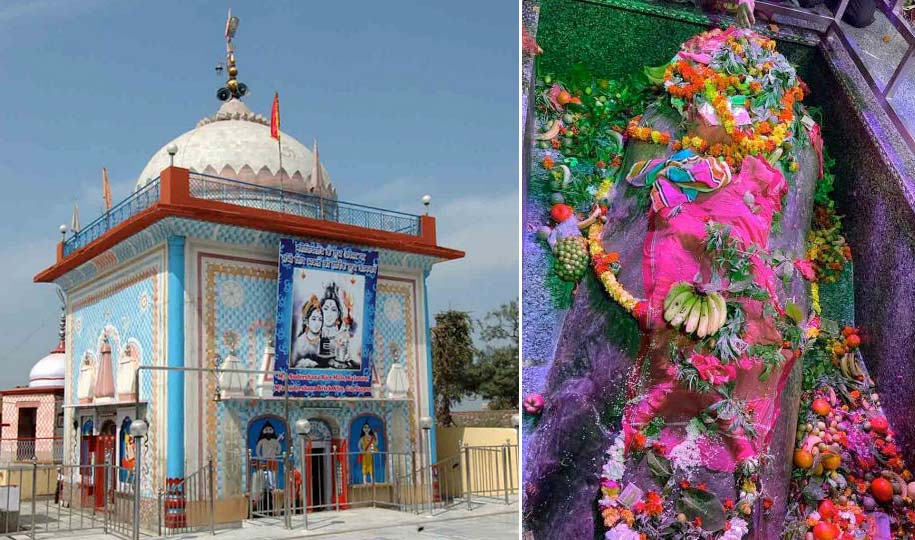
These sites, like branches of the same tree, offer varying shades of stillness and story.
Preparing for a Conscious Visit – Mindful Travel Tips
A visit to Pandori Dham is about arriving prepared—in body, mind, and spirit. When approached with awareness, even a few hours at the temple can feel like a deep inner reset.
Travel Light, Arrive Fully Present
The best time to visit is April during Baisakhi or the cooler winter months, when the air is crisp, the energy is serene, and the temple atmosphere feels especially alive with devotion.

Before your visit, take time to set an intention. Write in a journal, silence your phone, or dedicate a day to quiet. Carry essentials like covered headwear, modest clothing, and a mat if you plan to sit in prayer or reflection.
Inside the shrine, maintain silence, avoid photography, and respect spaces meant for worship. If possible, participate in seva, whether by helping serve langar or simply offering your time with sincerity.
A mindful journey begins not on the road, but in the heart.
Why Spaces Like Pandori Dham Matter in Modern India
In an era shaped by screens, deadlines, and constant notifications, more people are searching for deeper meaning. Spiritual spaces like Pandori Dham are emerging as essential sanctuaries—offering inner calm in a world that rarely slows down.

Why It Matters:
- Counters growing digital fatigue, emotional burnout, and mental stress
- Offers a grounding sense of identity in today’s fast-changing world
- Serves as a spiritual anchor for community and cultural continuity
- Encourages travel that nourishes the soul, not just the feed
- Symbolizes enduring peace in a time of constant distraction
We may not control time—but we can choose where to spend it meaningfully.
Also Read:
- Digital Burnout: 7 Habits to Reclaim Balance in Hyper connected World
- The Eternal Light of Mahadev: Journey Through the 12 Jyotirlingas of India
FAQ: Pandori Dham
What is Pandori Dham famous for?
It’s a 500-year-old Vaishnav temple known for its peaceful aura, and spiritual retreat experience. Pandori Dham was founded by Shri Bhagwanji, a disciple of Krishnadas Payahari. It stands as a prominent Vaishnav temple in Punjab and forms part of the sacred network of 52 Vaishnav dvaras across India.
When is the best time to visit Pandori Dham?
The ideal time to visit Pandori Dham is during the Baisakhi festival in April or the winter months. These periods offer a calm climate, vibrant spiritual energy, and the opportunity to witness rituals and seva at their fullest.
Is Pandori Dham suitable for solo spiritual travelers?
Yes, Pandori Dham is perfect for solo travelers seeking inner peace. The serene surroundings, daily rituals, and welcoming community offer a reflective space for mindfulness, self-inquiry, and emotional clarity without the distractions of typical tourist destinations.
Conclusion
The Real Pilgrimage Is Inward. A visit to Pandori Dham is more than a temple stop—it’s a return to stillness, service, and soul. From daily rituals to sacred legends, quiet gardens to shared langar, every moment offers a chance to reflect and realign.
Come without an agenda. Arrive with openness. Whether you stay for an hour or a day, you may leave lighter, clearer, more connected.
As the saying goes, “Not all who wander are lost—some are simply finding peace.”
If this journey spoke to you, share it forward. Someone else may be seeking exactly what Pandori Dham quietly offers. Plan your mindful journey to Pandori Dham. Find silence, not sights.
Share your Review
Our Digital Imprints:
About the Author: Anuj Mahajan is a Mass Communication Specialist, ICF Certified Coach & Corporate Trainer. Motivational Speaker / NLP Lifecoach. With expertise spanning filmmaking, business coaching, motivational speaking, blog writing, and authoring, he embodies versatility and mastery across diverse fields.
Chief Operating Officer: Nuteq Entertainment Pvt Ltd, and Co-Founder: Trendvisionz – A Premier Digital Marketing Agency in India
Get Connected to us with our Newsletters- Transforming Lives… Creating the magic. Just – Believe ~ Practice ~ Perform BizTech Chronicle… Navigating Tomorrow’s Tech Frontiers 🚀
Join my LinkedIn Group: Digital Marketing, Content Creation World Group
Follow me on Twitter or LinkedIn. Check out my website.
✍️ A Note from the Editor
At TrendVisionz, we craft each article with purpose—guided by research, passion, and the belief that storytelling can spark change. We’ve kept our content open and free for all, because we believe knowledge should never be behind a paywall.
But creating quality digital content takes time, heart, and resources. If this article resonated with you, we’d be deeply grateful for your support. Even $10/month can help us keep producing content that informs, empowers, and uplifts.
💛 Support our work: You can contribute directly via PayPal or email us at anujmahajan@trendvisionz.com to set up your monthly support.
Thank you for believing in independent digital journalism. —Editor




3 comments
[…] Posts The Conscious Retreat: Why Pandori Dham is More Than a Temple… Every Layer Counts: Future-Proofing with Multi-Layer Insulation Technology Citizenship by […]
There is definately a lot to find out about this subject. I like all the points you made
I have been reading out some of your stories and it’s nice stuff. I will make sure to bookmark your site.
Comments are closed.